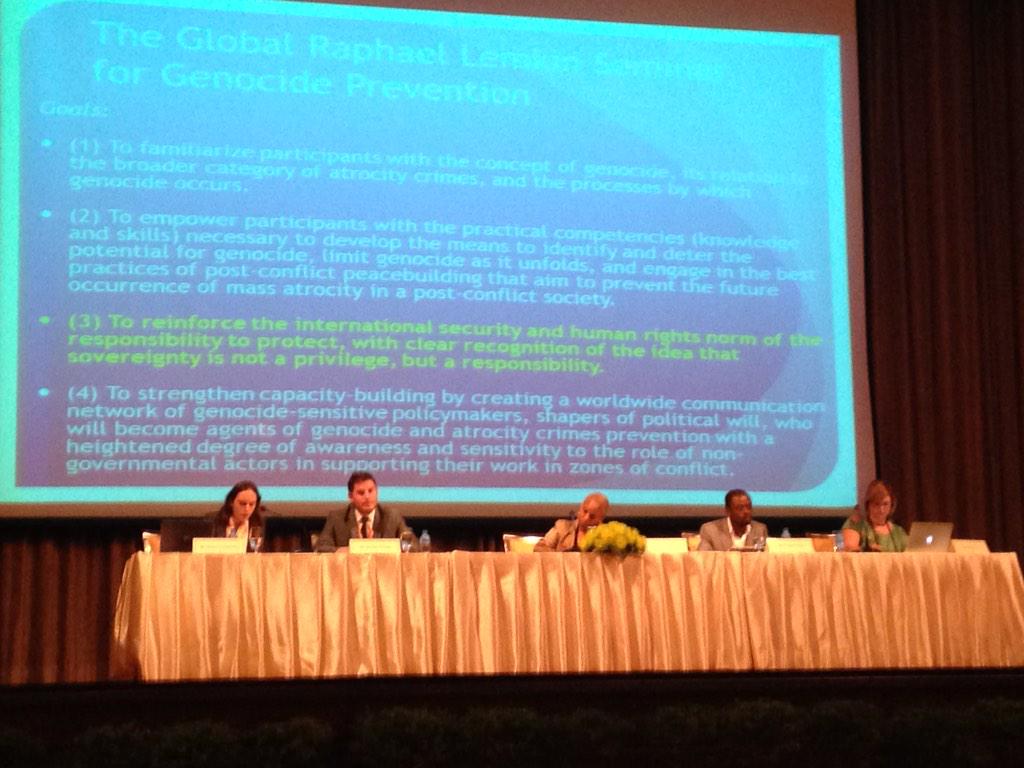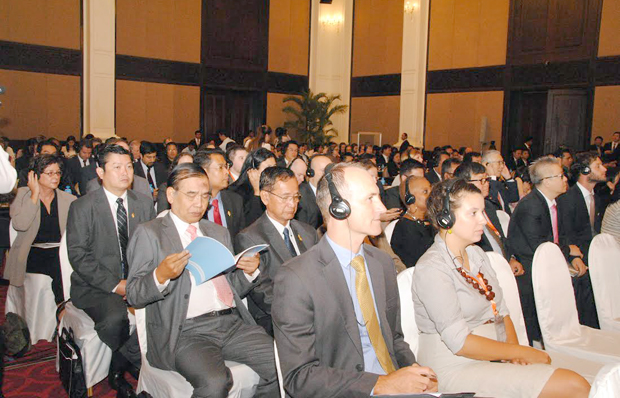PHNOM PENH, CAMBODIA – Nearly ten years ago at the 2005 World Summit, 191 representatives and leaders of UN Member States met in New York and agreed upon, among other important principles, the Responsibility to Protect (R2P) norm. “Each individual State has the responsibility to protect its populations from genocide, war crimes, ethnic cleansing and crimes against humanity,” reads Paragraph 138 of the 2005 Summit Outcome Document. “This responsibility entails the prevention of such crimes, including their incitement, through appropriate and necessary means.”
 On February 26 and 27, 2015, AIPR’s Director of Policy and Planning Samantha Capicotto joined colleagues from across the globe to commemorate the 10th anniversary of the adoption of R2P at a conference co-organized by the Asia Pacific Centre for the Responsibility to Protect, the Cambodian Institute for Co-operation and Peace, the Global Centre for the Responsibility to Protect, The Stanley Foundation and the International Coalition for the Responsibility to Protect. The conference, “The Responsibility to Protect at 10: Progress, Challenges and Opportunities in the Asia Pacific,” highlighted how far R2P has come and considered how the principle can be further embedded into state practice and into the work of regional and sub-regional organizations across Asia Pacific and beyond.
On February 26 and 27, 2015, AIPR’s Director of Policy and Planning Samantha Capicotto joined colleagues from across the globe to commemorate the 10th anniversary of the adoption of R2P at a conference co-organized by the Asia Pacific Centre for the Responsibility to Protect, the Cambodian Institute for Co-operation and Peace, the Global Centre for the Responsibility to Protect, The Stanley Foundation and the International Coalition for the Responsibility to Protect. The conference, “The Responsibility to Protect at 10: Progress, Challenges and Opportunities in the Asia Pacific,” highlighted how far R2P has come and considered how the principle can be further embedded into state practice and into the work of regional and sub-regional organizations across Asia Pacific and beyond.
 On February 27, Mrs. Capicotto shared her perspective on these topics at a panel titled, “Training and Educating for Prevention: Lessons Learned, Future Directions.” The lunchtime discussion was chaired by the Stanley Foundation’s Angela Bruce-Raeburn and featured Sarah Teitt of the Asia Pacific Centre for the Responsibility to Protect, Mr. Frank Okyere of the Kofi Annan International Peacekeeping Training Centre, Ghana, and Patrick Travers of the UN Office of the Special Advisor on the Prevention of Genocide and R2P. Mrs. Capicotto’s presentation focused on AIPR’s methodology and lessons learned from our work in education for prevention.
On February 27, Mrs. Capicotto shared her perspective on these topics at a panel titled, “Training and Educating for Prevention: Lessons Learned, Future Directions.” The lunchtime discussion was chaired by the Stanley Foundation’s Angela Bruce-Raeburn and featured Sarah Teitt of the Asia Pacific Centre for the Responsibility to Protect, Mr. Frank Okyere of the Kofi Annan International Peacekeeping Training Centre, Ghana, and Patrick Travers of the UN Office of the Special Advisor on the Prevention of Genocide and R2P. Mrs. Capicotto’s presentation focused on AIPR’s methodology and lessons learned from our work in education for prevention.
Specifically, she shared, among other topics, an overview of AIPR’s programs and the top five lessons AIPR has learned since launching our work in 2008. She emphasized the importance of:
1) Ensuring course curricula for regional and national educational programs be developed with local actors who have engaged in previous training on general concepts of R2P and atrocity prevention policy development and practice;
2) Creating an interactive learning environment;
3) Connecting participants with experts on the various aspects of prevention from within their region, as well as outside, to share best practices. This can be done through employing diverse instructional teams and bringing in relevant observers for educational programs;
4) Harnessing the power of place whenever possible; and
5) Ensuring that the training itself is part of a continuous relationship with the participants and their institutions wherever possible. Follow-up is essential.
 Capicotto shared these five lessons with the goal of improving the quality of training in prevention overall. Taken together with the other presentations from her fellow panelists, plus the other keynotes and discussions, “The Responsibility to Protect at 10” was for Capicotto “an excellent meeting that brought together the many actors involved in furthering R2P.” She added, “The conference showed that this is no longer an emerging norm, but in fact a fully established norm challenging us now after 10 years to determine how it should be applied—it is no longer a question of if it should be.”
Capicotto shared these five lessons with the goal of improving the quality of training in prevention overall. Taken together with the other presentations from her fellow panelists, plus the other keynotes and discussions, “The Responsibility to Protect at 10” was for Capicotto “an excellent meeting that brought together the many actors involved in furthering R2P.” She added, “The conference showed that this is no longer an emerging norm, but in fact a fully established norm challenging us now after 10 years to determine how it should be applied—it is no longer a question of if it should be.”
